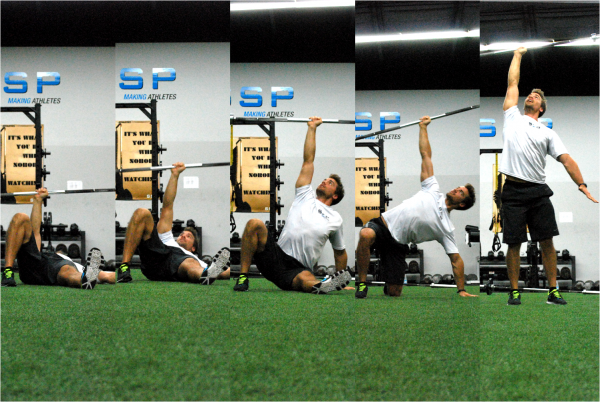 By: Jonathan TaylorSports Performance SpecialistSpectrum Sports Performance
By: Jonathan TaylorSports Performance SpecialistSpectrum Sports Performance
Train the mind and the body will follow. I have found in my many years of training that all limitation is self-imposed. Basically, who we are and how we perform is determined by what we believe first. Certainly consistent training produces physical adaptation, but the body, without the presence of a mindset, can only reach so far; it’s when we practice changing how we think that will ultimately produce lasting and continual change. The mind is primary.
Throughout our lives, we all hold certain, self-limiting attitudes that many times keep us from doing more. This certainly applies to training for a specific goal and during the workouts themselves. Many times, we often just stick to “what we’re good at,” and the rest we leave alone. But, if the mind is primary when training, I need to put myself in uncertain situations that make me confront those self-limiting thoughts and then learn to push through the fear and on to the other side. If I find myself achieving something I didn’t previously think possible, it pushes my self-limiting attitudes further away from my reality. If I believe I am capable of completing a certain workout, whether it’s moving a load on a barbell, or attaining a certain distance on a run, or achieving a standard time on an interval, then, as physical adaptation takes place, I can begin to push past my mental barriers. With this, however, you must start with being honest with yourself, confronting both physical and metal weakness, and then discover how to drive past those daunting limitations.
Knowing yourself is key. One example for me personally is that I hate to run. I have never liked running and I have always shied away from it. This was true, but I also had to see that I avoided running because I was never any good at it and that I didn’t want to “fail” in my own mind. When I was honest with myself, this drove me to begin looking at my self-limiting attitude. Previously I told myself I didn’t like running and that I would never be successful at it. Well, a year later of training and I placed third in a 6 mile mud race called, “The Highlander” and I then pushed myself further by completing “Tough Mudder,” a 12 mile mud race course that taxes everything in you. Before training, I couldn’t even run three miles! We do what our minds decide first. When I completed these races, I realized that the only thing that stopped me from being successful before was my mindset! Another example is a few years back I couldn’t complete hardly any pull-ups. I always avoided doing them in workouts because I was awful at them! Yet, I begin to force myself to do pull-ups in almost every single workout whether I failed or not. Now, I can hit 35 pull-ups in a row! Not a bad number for me who could hardly squeak out 8 before! Success produces confidence and confidence produces a stronger mind.
This, I believe, also applies to high intensity training. When completing high, anaerobic intervals or working through a difficult metabolic conditioning day, its impossible to turn off the “internal dialogue” that tells you just to quit. So, how does one push past those barriers of self-limitation and internal dialogue? Here are a few tips for you to practice breaking through mental barriers, which will in-turn smash through plateaus and you just might find yourself doing more than you thought you ever could:
- Set attainable goals. I know this might seem like common knowledge but if you don’t have a goal in front of you it is more difficult to stay motivated. Training hard for a purpose is more sustainable as opposed to training hard without a purpose. Set goals and go after it!
- Train with a partner. Again, seems obvious, but when you train with another person, there is more of a competitive nature involved, which in turns helps you push. Another great way to partner train is what I like to call “tag team” style training. For example, as one partner lunges a certain distance, the other partner has to complete rope slams until the person lunging returns. Another example would be partner 1 rows 250m while partner 2 holds the pillar position until completed. These little program design tricks can help teach you to push harder when you train.
- Eat well and often. Your body can’t run optimally when feeding on garbage. If you find yourself lethargic or having difficulty pushing through workouts, look at your nutrition first. That might be the weakest link to better performance! Several small meals, spaced out throughout the day is recommended. Also, limiting your caloric intake below 500 calories per meal helps prevent too much insulin from being secreted, which happens due to rising blood-sugar levels.
- Consequence/Reward training. Set rewards and consequences for outcomes during workout sessions. For example, a reward would be a post-workout chocolate milk if a metabolic circuit was completed in a set time. An example of consequence training would be if I don’t hit certain numbers during an interval session, I have to then run 3×300 shuttles at the end of the workout. Having rewards and consequences are a big motivator to push harder during your workouts.
- Top your time/reps. Week one, time yourself how long it takes you to complete a conditioning circuit. Week two, top your time in the same circuit by 15 sec. Week three, top your week two time by 10 sec. Also, an example of top your repetition would be to use Tabata Sets. The Tabata Set format is 20 sec. of work, 10 sec. of rest, repeated 8 times. This can be used to try and increase the volume of your reps per week. For example, let’s use simple body/air squats. Week one you would shoot for 17 reps per 20 sec for the duration; week two shoot for 18 reps; week three shoot for 19 reps. Also, logging your numbers helps establish a personal standard and can also help set a load/time/rep baseline that you can try and beat with each successive week of training.
- Practice diaphragmatic breathing. Breathing from your diaphragm (stomach moves out) helps receive more oxygen per breath as opposed to chest breathing (lungs move out). When deep in a hard workout, focus on pushing your stomach out and receiving oxygen in through the diaphragm, not the chest for each breath. It is difficult to do when the heart rate is elevated, but if practiced, it can become a great tool to “stay in it” mentally, as your body will utilize more oxygen per breath.
- Train intensity. Many are used to “training” without the component of intensity. Intensity could easily be defined as the energy system demand during a given workout. Go hard, not long. Duration has an inverse relationship with intensity, meaning, the longer the workout, the less intense it is. Depending on your goal, you will get much more out of a metabolic resistance training circuit or a high intensity interval session than if you just took your time with long rests. The more you train the intensity component in a workout, the more your body AND mind adapts to the stimulus. Have a strong mind, and as a consequence, you will have a strong body.

Leave a Reply